
Mr. Bennett has, in essence, thrown down the gauntlet and tried to restore Fuchida’s reputation by attacking mine. Having defended myself of the charges laid at my doorstep, I would like to take this opportunity to lay out several more instances demonstrating that Fuchida’s written battle accounts are verifiably false.
Mr. Bennett will recall that I told him that additional “minefields” regarding Fuchida’s credibility probably awaited him, should anyone be inclined to go look for them. I also told him on the night of 14 March, 2012, that I had no real motivation to dig them up, as they didn’t pertain to my current research. However, having subsequently been asked to defend myself against a rather lengthy document full of personal attacks against myself and my co-author, and having been obligated to waste a couple weeks of my life in the process, I discovered that I had all the motivation I needed to go looking. And they didn’t take long to find.
I should note before I start that these are not the product of my own research. Instead, they are the product of other reputable researchers within the broader historical community interested in the Imperial Japanese Navy (IJN). Each of these individuals was doing research on incidents of interest to them, and each of them encountered inconsistencies within Fuchida’s accounts. They then used Japanese primary sources (typically operational records) to try validating Fuchida’s points, and each found him in error.
There are two points worth making here. First, it is worth noting that practically nobody within the larger community of IJN researchers views Fuchida as a reliable source. The common view on the matter is that if Fuchida is to be used as a source at all, he must be checked against other more reliable sources. Second, Mr. Bennett should be very, very careful of trying to impeach my credibility as an historian, in that attacks against my sources and methodologies cannot be made in isolation. Instead, they are not only attacks against me, and my co-authors, but also against a broader community of researchers— John Lundstrom, Osamu Tagaya, J. Michael Wenger, Henry Sakaida, Richard Frank, Don Kehn, and others—whose collective expertise vastly outweighs Mr. Bennett’s.
I have no doubt whatever that any additional information concerning Fuchida’s prevarications will make absolutely no discernable indentation in Mr. Bennett’s admiration for the subject of his screenplay. As the old saying goes, “You can lead a horse to water, but you can’t make him drink.” However, they are presented here so that impartial readers may be aware of Fuchida’s substantial track record for prevarication.
Here’s the synopsis. On 5 April, 1942, Kido Butai was operating some 200 miles off of Ceylon, and delivered an attack against the port of Colombo. In his book Midway (p.50) Fuchida relates that as he was approaching the target, he:
“suddenly spotted a formation of 12 enemy Swordfish-type torpedo planes. They were flying at a much lower altitude, without any fighter escort, and obviously had not noticed us. I quickly signaled Lieutenant Commander Itaya, the fighter group commander, who was flying to port, to close me. When he had done so, I pointed down toward the enemy formation motioned for him to attack. After a few moments, Itaya nodded and veered off to lead his fighters against the still unsuspecting enemy. The lumbering Swordfish, caught from above, were shot down to the last plane in one swift attack.”
Sadly for this account, other more detailed records show that the fighter escort preceded the bombers by a good 30 minutes. It was Hiryu’s fighters that claimed shooting down eight Swordfish (of which there were actually six, not the dozen claimed by Fuchida), at 0732.
Hiryu's kodos, with the kills in question, are presented here: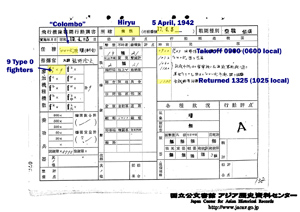
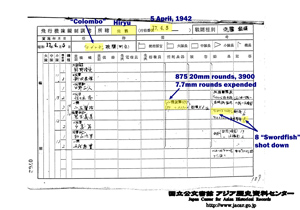
Secondary sources supporting this include Bloody Shambles vol. 2, p. 395, which says that “The A6Ms were the first to arrive at 0732”. Likewise, Michel Ledet’s Samourai sur Porte-Avions says on p. 157 that the first victims of the Japanese were the Swordfish of 788 Squadron, which were intercepted over Colombo “vers 07 h 30” by the Zeros of Lt Nono, who was Hiryu’s fighter leader. Noted IJNAF expert Osamu Tagaya’s Val book says that “Zero-sens sweeping ahead of the main formation made short work of six Swordfish ...” And Bloody Shambles vol. 2, p. 402 says that the Kates were escorted by Zeros from Zuikaku and not those from Akagi. The fact that apparently no Zuikaku fighter claimed any enemy aircraft seems consistent with this suggestion, as we know that the Hurricane and Fulmar attacks were concentrated on the Vals and their escorts.
Fuchida says that he spotted the Swordfish “as we closed the target” (i.e., south of Colombo) and that he then swung around to the north of Colombo and then “dashed in toward the objective”. But the Swordfish were attacked over Colombo, heading south to land at Ratamalana. Fuchida could not have seen them from south of Ratmalana, especially since, as he correctly notes, there were a lot of clouds in the area. Taken together, it is clear that Fuchida clearly had nothing to do with either detecting or shooting down the Swordfish—they had all been destroyed before he arrived in the area. Fuchida nevertheless managed to claim some glory for himself regardless of the facts.
(I am indebted to both Rob Stuart and Eugen Pinak for their insights on this matter.)
Here’s the synopsis: Fuchida claims in God’s Samurai (p. 60) to have led the attack that hit Trincomalee, Ceylon on the morning of 9 April, 1942. After returning to Akagi, he was on board the flagship when she was attacked by British Blenheims at 1045. Fuchida claims he then subsequently took off from Akagi, and headed towards the location where dive-bombers from Carrier Division 2 were attacking the British carrier Hermes and her escorts. Fuchida describes arriving just in time to witness Hermes’ final demise “under the hail of bombs.”
There are several problems with this. First, Akagi was bombed at 1045. Hermes, located some 155nm away from Akagi, sank at 1055. Obviously, it would take a very speedy plane indeed to cover 150nm in 10 minutes. Similarly, Akagi’s kodochoshos only show Fuchida flying a single mission that day, namely the morning attack against Trincomalee.
Akagi's kodos for this operation are reproduced here. They show, first, the morning strike against Trincomalee taking off: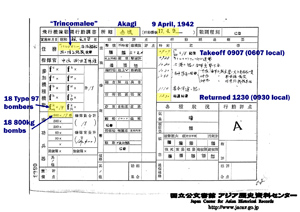
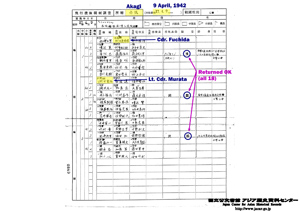
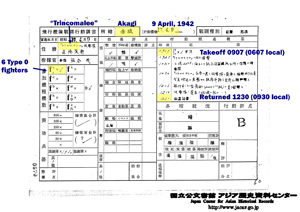
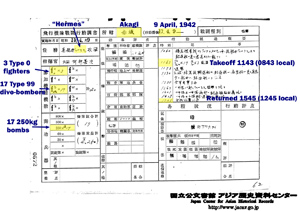
Finally, it is intriguing to note the morphing of Fuchida’s account over time. In Midway (p. 52), he only claims to have witnessed the Blenheim attack against Akagi (which is reasonable enough given the timing of the return of the morning attack force) and makes no claims to have seen Hermes sink. However, by the time God’s Samurai comes out, Fuchida had become a witness to Hermes demise as well. Clearly, Fuchida was the sort of combat leader who needed to be where the action was, even if the action was in two different places at roughly the same time.
(I am indebted to Rob Stuart for his insights on this matter)
It’s always preferable to save the best for last, and this next anecdote is simply delectable. On 5 March, 1942, Japan’s carrier force, operating south of Java, launched a powerful strike against the port of Tjilitjap, which lies on the southern coast of the island. Fuchida relates details of this attack in Prange’s book God’s Samurai. Fuchida starts off by supplying erroneous operational details on the attack, claiming that Tjilitjap was bombed by Kido Butai on 3 March, rather than the 5th. Fuchida claims 180 aircraft were used, when subsequent work with the kodochoshos indicate that only 149 machines were employed in the attack. These errors would be innocent enough, except for what Fuchida related next.
During the course of the Japanese attack, Fuchida claims that his aircraft was badly hit by flak, damaging a wing fuel tank. His pilot, the famous torpedo attack expert Murata Shigeharu, supposedly diverted the aircraft north “towards the nearest Japanese base” in Borneo. Fuchida relates that they ended up crashing in southern Borneo, which is some 300nm north of Tjilitjap, across the Java Sea. The crash killed the plane’s gunner. Murata and Fuchida then spent the next several days wandering in the jungle before reaching a native village, chartering a boat, and sailing to Kendari, in the Celebes, where they were rescued.
As it turns out, absolutely none of this occurred, as related by J. Michael Wenger in a post here:
http://www.pearlharborattacked.com/cgi-bin/IKONBOARDNEW312a/ikonboard.cgi?act=Print;f=11;t=78
After reviewing all of the Japanese primary and secondary material in my possession, I am forced to conclude that the story of Fuchida's "Borneo ordeal" is a product of his overactive imagination. Coming to that conclusion is all the more regrettable as it is such a compelling story. However, there is just no other conclusion to draw.
After my last research trip to Japan, I remembered that I had forgotten to check out Fuchida's story regarding the Borneo incident and the Tjilitjap raid of 5 March. Needless to say, I waited breathlessly for the document copies to arrive to see what additional information might be contained therein.
It is very interesting to observe the following:
1. There is no such loss (of either Murata or Fuchida) noted in Akagi's kodochoshos for the period of March, 1942.
2. In the Japanese War History volume chronicling the activities of Kido Butai during February-March, 1942, there is no mention made of this incident, which is quite remarkable. The loss- even temporarily- of Fuchida and Murata would have hit Kido Butai like a thunderbolt, and it is inconceivable that any such occurrence would have gone unnoted.
3. I have been able to find nothing in Murata's biography concerning such an incident.
4. At the time of the Tjilitjap raid, Nagumo's carriers operated SOUTH of Java. It should be noted that Borneo is NORTH of Java, and situated about 400 miles north of Kido Butai, completely on the other side of Java. What in the name of heaven would Fuchida (or anyone else) be doing up there??
5. Finally, and most importantly, there are a number of problems with the story itself. To wit…
a. The Tjilitjap raid occurred on 5 March, NOT 3 March.
b. Akagi's VT strike unit split into three (3) divisions of six (6) aircraft each, with the division commanders being Fuchida, Murata, and Furukawa. Hence, Murata and Fuchida were not even in the same aircraft.
c. There were no aircraft WHATSOEVER lost from Akagi during this strike.
d. The raid did NOT consist of 180 aircraft. The Tjilitjap strike was organized into two separate waves- a mixed strike of 96 aircraft under Fuchida and a follow-up strike of 53 aircraft under Kusumi, for a total of 149 aircraft.
The endnotes in God's Samurai support the incident with a single interview with Fuchida in 1964, further supported by some unidentified manuscript material.
In support of Mr. Wenger's assertions, Akagi's kodos are reproduced here. The first shows the particulars of the morning takeoff of Fuchida's attack force:
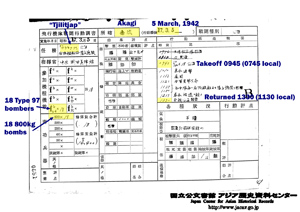
The second page shows the strike roster for the Tjilitjap attack. Note that both Fuchida and Murata are flying in different aircraft, much as they would a month later during their attack on Trincomalee. Note, too, the fact that all 18 aircraft are clearly marked as "OK" upon return:
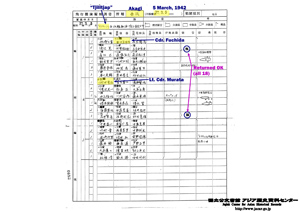
In other words, Fuchida was willing to completely fabricate tall tales from whole cloth for dramatic effect. Commenting on this account, noted IJN researcher Don Kehn, Jr. simply remarked “I'm not much interested in [the Battle of Midway]—in fact, not at all—but find it puzzling that Fuchida's capacity to dissemble is even questioned.” Indeed, for sheer audacity, this particular set of prevarications is hard to top.
Beyond the ironclad refutation of Fuchida’s fable that Akagi’s kodochoshos once again provide—not to mention the absence of corroborating details in other Japanese sources of an event that would likely have been an important news item in Japan—other problems in simple logic arise. Fuchida nowhere explains why Murata would have diverted his damaged aircraft north, away from Akagi (which was operating south of Java during these attacks), so as to fly a longer distance to Borneo instead. Indeed, with a damaged wing fuel tank, it is almost impossible that Fuchida could have reached Borneo at all. The normal range for a combat-loaded Type 97 attack bomber was about 530nm. Having already flown 200nm to make the attack, and then suffered a hit that would have drained half of the plane’s remaining fuel, the range of Fuchida’s aircraft was probably no more than 175nm, meaning he would simply have crashed into the Java Sea well short of Borneo had he turned north as he claims.
Likewise, Fuchida doesn’t care to explain why, if he chartered a junk to take Murata and himself to safety, he would have chosen to sail to Kendari. Given a hypothetical landing spot somewhere in southern Borneo (and securing a boat near, say, Pantai Kubu), the Japanese base at Banjarmasin (which had been captured 10 February, 1942) would have been about 200nm away to the east. Singapore would have been approximately 520nm distant to the west. Kendari, on the other hand, would have been more than 900nm away, and would have required Fuchida to sail right past Banjarmasin in order to reach it. Obviously, making for a closer Japanese base, and getting a radio, was a much more efficient means of effecting a rescue than sailing for several more days through still-contested waters to arrive at Kido Butai’s operating anchorage.
Regarding the plausibility of this ridiculous tale, and the fact that he might one day have been required to defend it to Prange and others, we can only speculate that Fuchida’s apparent weaknesses in geography were only matched by his lack of comprehension regarding the operational details that postwar researchers would be able to bring to the table.
These three latest whoppers demonstrate yet again, if any further proof were possibly needed, that Fuchida is not a source to be trusted in the study of the Pacific War. His misstatements continue to haunt history, and probably will continue to do so for decades to come.

